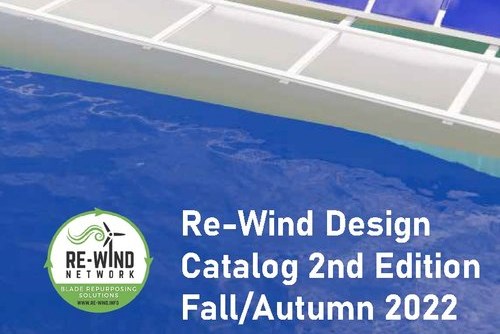Re-Wind Network publishes second edition of repurposed wind blade design catalog
The fall/autumn 2022 Design Catalog presents designs and details of structures and products made from end-of-life repurposed wind turbine blades, with a new section on marine structures.

Photo Credit: Re-Wind Network
Re-Wind Network has published the second edition of its fall/autumn 2022 Design Catalog, which presents designs and details of structures and products made from end-of-life (EOL) repurposed wind turbine blades that are available from the Re-Wind Network research team.
New to the fall 2022 edition is a section on marine structures (floating photovoltaics (PV) platforms, jetties and buoys), and new pages on single-girder bridges, as well as images of Re-Wind’s recent BladeBridge installations in Cork, Ireland, and Draperstown, Northern Ireland, U.K. Models based on a Siemens Gamesa Renewable Energy (SGRE, Paris, France) B45 blade.
See Re-Wind Network’s fall 2021 catalog here.
Models of the blades used in the designs were produced at the Georgia Institute of Technology (Atlanta) using in-house software from LiDAR scans or documentation of five decommissioned wind turbine blades. Graphics were produced in Rhinoceros (Robert McNeel & Associates, Seattle, Wash., U.S.) and Enscape (Karlsruhe, Germany) software. The blades used in the designs are listed below:
- Nordex N29 250 kW turbine — 13.4-m LM blade.
- Vestas V44 600 kW turbine — 21-m blade.
- General Electric GE 1.5-77 1.5 MW turbine — 37-m blade.
- Liberty Clipper C96 2.5 MW turbine — 46.7-m blade.
- Siemens Gamesa SWT-2.3-93 turbine — 45-m blade.
According to the Re-Wind Network, each blade above represent typical sizes and lengths of blades currently coming out of service globally. Designs detailed in the catalog include BladeMarine, BladePlatform, BladeJetty and BladeBuoy, in addition to BladePoles, BladeBarriers, BladeShelters, BladeFarming, and various bride and boardwalk types.
The Re-Wind Network is a network of faculty, staff and students at five academic institutions — Georgia Institute of Technology, University College Cork, Queen’s University Belfast, City University of New York and Munster Technological University — and industry affiliates.
Download the catalog here.
Related Content
-
Composites end markets: Automotive (2024)
Recent trends in automotive composites include new materials and developments for battery electric vehicles, hydrogen fuel cell technologies, and recycled and bio-based materials.
-
Honda begins production of 2025 CR-V e:FCEV with Type 4 hydrogen tanks in U.S.
Model includes new technologies produced at Performance Manufacturing Center (PMC) in Marysville, Ohio, which is part of Honda hydrogen business strategy that includes Class 8 trucks.
-
Recycling end-of-life composite parts: New methods, markets
From infrastructure solutions to consumer products, Polish recycler Anmet and Netherlands-based researchers are developing new methods for repurposing wind turbine blades and other composite parts.















.jpg;maxWidth=300;quality=90)
